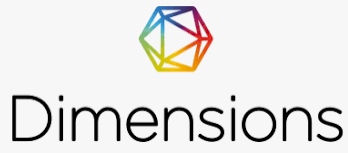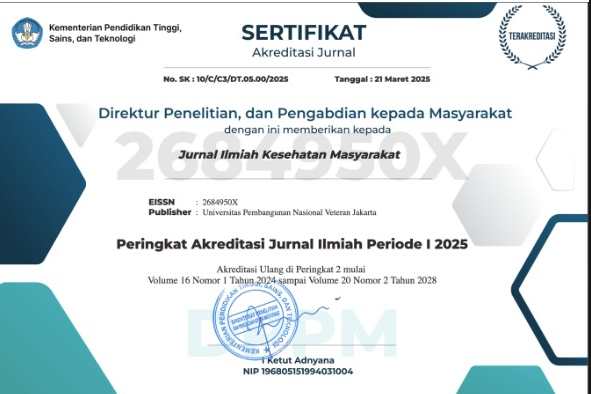Pajanan Timbal Terhadap Tingkat Kecerdasan Anak
Abstract
Latar belakang: Keracunan timbal menyebabkan penyakit organ multisistemik dengan gejala non spesifik pada kelainan neurologis, seperti penurunan IQ (intelligence quotient), ketidakmampuan belajar, pertumbuhan yang lambat, hiperaktif, perilaku antisosial, pendengaran terganggu serta pada tingkat paparan yang tinggi dapat menyebabkan ADHD (Attention-Deficit/ Hyperactivity Disorder). Artikel ini bertujuan untuk mengetahui bahaya pajanan timbal terhadap tingkat kecerdasan anak.Metode: Merupakan systematic review dengan sumber data penelitian ini berasal dari 6 jurnal elektronik (DOAJ, ScienceDirect, CDC, NCBI, Springer Link, Proqeust). Inklusi jurnal termasuk; publikasi kurang dari 20 tahun kebelakang, diutamakan jurnal internasional, jurnal keracunan timbal yang berhubungan dengan penurunan kecerdasan, dan jurnal dengan kadar timbal dalam darah < 10 µg/dL. Didapatkan 29 jurnal yang terdiri dari 22 jurnal berbahasa Inggris dan 7 jurnal berbahasa Indonesia. Kata kunci yang digunakan yaitu keracunan timbal, lead exposure, lead poisoning, systematic review, children, Intelligent Quotient (IQ).
Hasil: Faktor yang signifikan pada penelitian ini, yaitu faktor lingkungan rumah dan pendidikan orangtua. Kadar timbal dengan penurunan IQ tertinggi dari empat negara yaitu di Negara Amerika dengan penurunan IQ tujuh kali lipat.
Kesimpulan: Dapat disimpulkan bahwa keracunan timbal dapat mempengaruhi kecerdasan. Adanya timbal dalam darah ≥5 µg/dL dapat menurunkan IQ sebesar ≥7,4 kali.
Kata kunci: Anak, Darah, Kecerdasan, Pajanan timbal
Lead Exposure To The Level Of Intelligence Children
Abstract
Background: Lead poisoning causes multisystemic organ disease with non-specific symptoms of neurological disorders, such as decreased IQ (intelligence quotient), learning disabilities, slow growth, hyperactivity, antisocial behavior, impaired hearing and high levels of exposure can cause ADHD (Attention-Deficit / Hyperactivity Disorder). This article aimed to know the danger of lead exposure to the level of intelligence of children.
Method: This article is a systematic review with the source data of this research comes from 6 electronic journals (DOAJ, ScienceDirect, CDC, NCBI, Springer Link, Proqeust). Include journal entries; publication less than 20 years back, preferably international journals, lead poisoning journals related to decreased intelligence, and journals with blood lead levels <10 μg / dL. There are 29 journals consisting of 22 English-language journals and 7 Indonesian-language journals. Keywords used are lead poisoning, lead exposure, lead poisoning, systematic review, children, Intelligent Quotient (IQ).
Results: Significant factors in this study, namely poor environmental factors and parent education. Lead levels with the highest IQ decline from four countries namely in the United States with a sevenfold decrease in IQ.
Conclusion: It can be concluded that lead poisoning can affect intelligence. The presence of lead in blood ≥5 μg / dL can decrease IQ by ≥7.4 times.
Keyword: Child, Blood, Intelligence, Lead exposure
References
Gusnita D. Pencemaran logam berat timbal (pb) di udara dan upaya penghapusan bensin bertimbal. Ber Dirgant. 2012;13(3):95–101.
Muller H, Regard S, Petriccioli N, Kherad O. Traditional medicine: a rare cause of lead poisoning in Western countries. F1000Research. 2013;250:1–5.
Daneshparvar M, Mostafavi SA, Jeddi MZ, Yunesian M, Mesdaghinia A, Mahvi AH, et al. The role of lead exposure Attention-Deficit/Hyperactivity Disorder in children: A systematic review. Iran J Psychiatry. 2016;11(1):1–14.
Hou S, Yuan L, Jin P, Ding B, Qin N, Li L, et al. A clinical study of the effects of lead poisoning on the intelligence and neurobehavioral abilities of children. Theor Biol Med Model. 2013;10(1):1– 10.
WHO. Global Health Risks: Mortality and burden of disease attributable to selected major risks. Bull World Health Organ [Internet]. 2009;87:646–646. Available from:
http://www.who.int/healthinfo/global_bu rden_disease/GlobalHealthRisks_report_ full.pdf
2011 Annual Childhood Lead Florida Lead Poisoning Prevention & Healthy Homes Program 2011 Annual Childhood Surveillance Report. 2012;(August).
Wang S, Zhang J. Blood lead levels in children, China. Environ Res [Internet]. 2006 Jul 1 [cited 2018 Feb 28];101(3):412–8. Available from: https://www.sciencedirect.com/science/ar ticle/pii/S001393510500188X?via%3Dih ub
Jain NB, Hu H. Childhood correlates of blood lead levels in Mumbai and Delhi. Environ Health Perspect. 2006;114(3):466–70.
McQuirter JL, Rothenberg SJ, Dinkins G a., Kondrashov V, Manalo M, Todd AC, et al. Lead and Lead Poisoning from Antiquity to Modern Times. Environ Health Perspect [Internet]. 2013;115(1):1–2. Available from: http://www.pubmedcentral.nih.gov/articl erender.fcgi?artid=1519587&tool=pmce ntrez&rendertype=abstract%5Cnhttp://ba ses.bireme.br/cgi- bin/wxislind.exe/iah/online/?IsisScript=i ah/iah.xis&src=google&base= REPIDISCA&lang=p&nextAct ion=lnk&expr
Jurnal Ilmiah Kesehatan Masyarakat Vol. 12 Edisi 2, 2020
Mazumdar M, Bellinger DC, Gregas M, Abanilla K, Bacic J, Needleman HL. Low-level environmental lead exposure in childhood and adult intellectual function: a follow-up study. Environ Heal. 2011;10(1):24.
Canfield RL, Henderson CR, Cory- Slechta DA, Cox C, Jusko TA, Lanphear BP. Intellectual Impairment in Children with Blood Lead Concentrations below
μg per Deciliter. N Engl J Med [Internet]. 2003;348(16):1517–26. Available from:
http://www.nejm.org/doi/abs/10.1056/NE JMoa022848
Jusko TA, Henderson CR, Lanphear BP, Cory-Slechta DA, Parsons PJ, Canfield RL. Blood Lead Concentrations < 10 μg/dL and Child Intelligence at 6 Years of Age. Environ Health Perspect [Internet]. 2008;116(2):243–8. Available from: http://www.ncbi.nlm.nih.gov/pmc/article s/2235210/
Kanedi M, Pebrice S, P WA. ANALISIS KADAR TIMBAL ( Pb ) PADA RAMBUT PEKERJA BENGKEL TAMBAL BAN DAN IKAN MAS DI SEPANJANG JALAN SOEKARNO- HATTA BANDAR LAMPUNG SECARA SPEKTROFOTOMETRI SERAPAN ATOM. :91–7.
Sanusi, Asih Mahmudah D. yang beredar di daerah Purwokerto, dengan metode spektrofotomeri serapan atom. Dekstruksi yang digunakan adalah dengan dekstruksi basah mengunakan campuran H 2 SO 4 dan HNO 3 . Pengambilan sampel menggunakan metode. 2010;7(3):123–34.
Gilmore JH. NIH Public Access. North. 2008;29(10):1883–9.
Budiyono, Haryanto B, Hamonangan E, Hindratmo B. Korelasi Timbal Dalam Darah Dan Tingkat Kecerdasan ( Majemuk ) Siswa Sekolah Dasar Di Sekitar Peleburan Aki Correlation Blood Lead Levels and Inteligence Levels Among Elementary School Students Living At Surrounding Used Battery Smelter in the Regency of. Ecolab. 2016;10(1):41–7.
Romli M, Setiani O. Hubungan Kadar
Plumbum ( Pb ) Dalam Darah dengan Prestasi Belajar Pada Anak Sekolah di SDN Grinting 01 Kecamatan Bulakamba Kabupaten Brebes. 2016;15(2):36–41.
Ratnasari DM, Sitaresmi MN, Mulyani NS. Hubungan Kadar Timbal Darah dengan Tingkat Inteligensi Anak. 2016;18(1):265–9.
Lo YC, Dooyema CA, Neri A, Durant J, Jefferies T, Medina-Marino A, et al. Childhood lead poisoning associated with gold ore processing: A village-level Investigation-Zamfara State, Nigeria, October-November 2010. Environ Health Perspect. 2012;120(10):1450–5.
Holmer I. Original article. 1989;15(1):58–65.
Lin S, Wang X, Yu ITS, Tang W, Miao J, Li J, et al. Environmental lead pollution and elevated blood lead levels among children in a rural area of china. Am J Public Health. 2011;101(5):834– 41.
Li Y, Qin J, Wei X, Li C, Wang J, Jiang M, et al. The risk factors of child lead poisoning in China: A meta-analysis. Int J Environ Res Public Health. 2016;13(3).
Karrari P, Mehrpour O, Abdollahi M. A systematic review on status of lead pollution and toxicity in Iran; Guidance for preventive measures. DARU, J Pharm Sci. 2012;20(1):1–17.
Graber LK, Asher D, Anandaraja N, Bopp RF, Merrill K, Cullen MR, et al. Childhood lead exposure after the phaseout of leaded gasoline: An ecological study of school-age children in Kampala, Uganda. Environ Health Perspect. 2010;118(6):884–9.
Liu J, Li L, Wang Y, Yan C, Liu X. Impact of Low Blood Lead Concentrations on IQ and School Performance in Chinese Children. PLoS One. 2013;8(5).
Chen AM, Dietrich KN, Ware JH, Radcliffe J, Rogan WJ. IQ and blood lead from 2 to 7 years of age: Are the effects in older children the residual of high blood lead concentrations in 2-year- olds? Environ Health Perspect [Internet]. 2005;113(5):597–601. Available from: http://ehp.niehs.nih.gov/members/2005/7
Jurnal Ilmiah Kesehatan Masyarakat 98 Volume 12 Edisi 2, 2020
/7625.pdf
Lewendon G, Kinra S, Nelder R, Cronin
T. Should children with developmental and behavioural problems be routinely screened for lead? Arch Dis Child. 2001;85(4):286–8.
Shah KK, Oleske JM, Gomez HF, Davidow AL, Bogden JD. Blood Lead Concentrations of Children in the United States: A Comparison of States Using Two Very Large Databases. J Pediatr [Internet]. 2017;185:218–23. Available from: http://linkinghub.elsevier.com/retrieve/pi i/S0022347617301695
Min MO, Singer LT, Kirchner HL, Minnes S, Short E, Hussain Z, et al.
Cognitive development and low-level lead exposure in poly-drug exposed children. Neurotoxicol Teratol. 2009;31(4):225–31.
Havens D, Pham M, Karr C, Daniell W. Blood Lead Levels and Risk Factors for Lead Exposure in a Pediatric Population in Ho Chi Minh City, Vietnam. Int J Environ Res Public Health [Internet]. 2018;15(2):93. Available from: http://www.mdpi.com/1660- 4601/15/1/93
Betts KS. Forum cdc Updates Guidelines for children ’ s lead exposure. Environ Health Perspect. 2012;120(7):A268.
Syahrizal D. Pengaruh plumbum (Pb) terhadap perkembangan anak. 2009;









.jpg)








